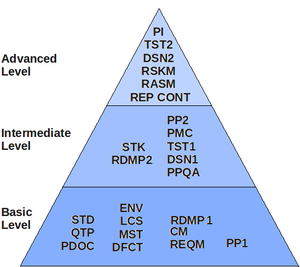- OpenSource Maturity Model
-
The QualiPSo OpenSource Maturity Model (OMM) is a methodology for assessing Free/Libre Open Source Software (FLOSS) and more specifically the FLOSS development process. This methodology is released under the Creative Commons license.
OMM helps in building trust in the development process of companies using or producing FLOSS. The aim of the methodology is to enable software companies to use FLOSS software in production and, in particular, in their main stream products and not only in prototypes. [1] [2]
OMM objectives are:
1. To provide FLOSS communities a basis for developing products efficiently and making their products trustworthy for the potential customers, and also for integrating companies.
2. To provide FLOSS integrators a basis for evaluating the processes used by the FLOSS communities.
OMM is interchangeably referred to as model and methodology. It is first a model that contains all ellements that have to be assessed, but it is also a set of rules and guidelines describing how to conduct the assessment process.Contents
General structure
OMM is organized in levels, each level is building on and including the trustworthy elements (TWE) at the lower level. The trustworthy elements included in OMM were collected or inspired by two sources:
1. FLOSS-TWEs gathered from an extensive survey conducted on FLOSS developers, FLOSS users, and FLOSS integrators [3]
2. CMMI Process Areas
Three maturity levels available in OMM are:
1. Basic level that can be easily reached by adopting a few necessary practices in the FLOSS development process
2. Intermediate level is the second level in OMM and can be achieved by fulfilling all trustworthy elements from the basic level and required trustworthy elements from the intermediate level.
3. The advanced level is the highest level that FLOSS projects can achieve by fulfiling all trustworthy elements from basic and intermediate levels and required trustworthy elements from the advanced level.List of trustworthy elements constituting the three OMM maturity levels:
Basic level:
PDOC – Product Documentation
STD – Use of Established and Widespread Standards
QTP – Quality of Test Plan
LCS – Licenses
ENV – Technical Environment
DFCT – Number of Commits and Bug Reports
MST – Maintainability and Stability
CM – Configuration Management
PP1 – Project Planning Part 1
REQM – Requirements Management
RDMP1 – Availability and Use of a (product) roadmap
Intermediate level:
RDMP2 – Availability and Use of a (product) roadmap
STK – Relationship between Stakeholders
PP2 – Project Planning Part 2
PMC – Project Monitoring and Control
TST1 – Test Part 1
DSN1 – Design Part 1
PPQA – Process and Product Quality Assurance
Advanced level:
PI – Product Integration
RSKM – Risk Management
TST2 – Test Part 2
While attempting to develop such a model, a few basic facts had been considered:
1. OMM is a process model for development by developers and integration of FLOSS products by integrators.
2. OMM is intended for use by individuals and development teams that may be spread across locations worldwide, hence the emphasis on simplicity and ease of use. Being simple but organized as an evolutionary model, OMM can be useful for companies as well. This approach helped to keep the model lean but still practical.
The OMM model is now tested and validated in real FLOSS projects [4] that are led by FLOSS communities or by software development companies.See also
References
1. Wittmann, Marion; Nambakam, Ranganatham. "CMM-like model for OSS". QualiPSo project web site. http://www.qualipso.org/sites/default/files/A6.D1.6.3CMM-LIKEMODELFOROSS.pdf. Retrieved June 2010.
2. Petrinja, Etiel; Sillitti, Alberto; Succi, Giancarlo (7–10 September 2008). "Overview on Trust in large FLOSS Communitie". Open Source Development, Communities and Quality. Milan, Italy: Springer. pp. 47-56. http://pascal.case.unibz.it/retrieve/4498/OverviewOnTrust_PetrinjaSillittiSucci_Manuscript.pdf.
3. Petrinja, Etiel; Nambakam, Ranganatham; Sillitti, Alberto (May 16–24, 2009). "Introducing the OpenSource Maturity Model". Emerging Trends in Free/Libre/Open Source Software Research and Development. Vancouver, Canada: ICSE 2009. http://dx.doi.org/10.1109/FLOSS.2009.5071358.
4. Petrinja, Etiel; Sillitti, Alberto; Succi, Giancarlo (30 May - 2 June 2010). "Comparing OpenBRR, QSOS, and OMM Assessment Models". Open Source Software: New Horizons. Notre Dame, Indiana, USA: Springer. pp. 224-238. http://www.inf.unibz.it/~gsucci/publications/images/ComparingOpenBRRQSOSandOMM%20Assessment%20Models.pdf.
As of 16 June 2010, this article is derived in whole or in part from Qalipso. The copyright holder has licensed the content utilized under CC-By-SA and GFDL. All relevant terms must be followed. The original text was at "OpenSource Maturity Model (OMM) evaluation".
External links
- Official QualiPSo OMM webpages "Developing a new Capability Maturity Model-like approach to assessing the quality of OSS". http://www.qualipso.org/trustworthy_process Official QualiPSo OMM webpages. Retrieved June 7, 2011.
- OMM on-line assessment questionnaire "QualiPSo OpenSource Maturity Model (OMM) evaluation". http://omm.qualipso.org OMM on-line assessment questionnaire. Retrieved June 7, 2011.
- OMM description "OMM Overview". http://qualipso.icmc.usp.br/OMM/ OMM description. Retrieved June 7, 2011.
Categories:- Free software culture and documents
- Maturity models
Wikimedia Foundation. 2010.

